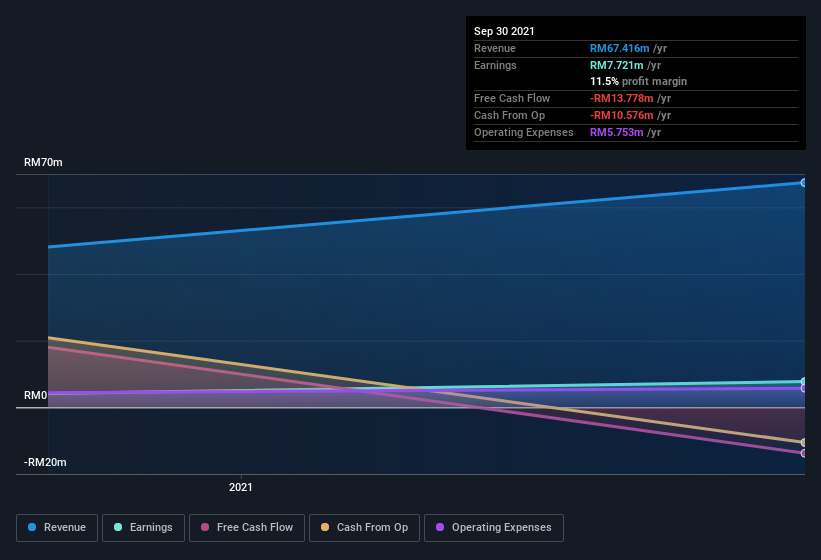- Malaysia
- /
- Specialty Stores
- /
- KLSE:LSH
Investors Shouldn't Be Too Comfortable With Lim Seong Hai Capital Berhad's (KLSE:LSH) Robust Earnings
Lim Seong Hai Capital Berhad (KLSE:LSH) announced strong profits, but the stock was stagnant. We did some digging, and we found some concerning factors in the details.
See our latest analysis for Lim Seong Hai Capital Berhad

A Closer Look At Lim Seong Hai Capital Berhad's Earnings
One key financial ratio used to measure how well a company converts its profit to free cash flow (FCF) is the accrual ratio. The accrual ratio subtracts the FCF from the profit for a given period, and divides the result by the average operating assets of the company over that time. You could think of the accrual ratio from cashflow as the 'non-FCF profit ratio'.
That means a negative accrual ratio is a good thing, because it shows that the company is bringing in more free cash flow than its profit would suggest. While it's not a problem to have a positive accrual ratio, indicating a certain level of non-cash profits, a high accrual ratio is arguably a bad thing, because it indicates paper profits are not matched by cash flow. That's because some academic studies have suggested that high accruals ratios tend to lead to lower profit or less profit growth.
Lim Seong Hai Capital Berhad has an accrual ratio of 0.84 for the year to September 2021. As a general rule, that bodes poorly for future profitability. And indeed, during the period the company didn't produce any free cash flow whatsoever. In the last twelve months it actually had negative free cash flow, with an outflow of RM14m despite its profit of RM7.72m, mentioned above. It's worth noting that Lim Seong Hai Capital Berhad generated positive FCF of RM18m a year ago, so at least they've done it in the past. The good news for shareholders is that Lim Seong Hai Capital Berhad's accrual ratio was much better last year, so this year's poor reading might simply be a case of a short term mismatch between profit and FCF. As a result, some shareholders may be looking for stronger cash conversion in the current year.
Note: we always recommend investors check balance sheet strength. Click here to be taken to our balance sheet analysis of Lim Seong Hai Capital Berhad.
Our Take On Lim Seong Hai Capital Berhad's Profit Performance
As we have made quite clear, we're a bit worried that Lim Seong Hai Capital Berhad didn't back up the last year's profit with free cashflow. For this reason, we think that Lim Seong Hai Capital Berhad's statutory profits may be a bad guide to its underlying earnings power, and might give investors an overly positive impression of the company. The good news is that, its earnings per share increased by 79% in the last year. The goal of this article has been to assess how well we can rely on the statutory earnings to reflect the company's potential, but there is plenty more to consider. So while earnings quality is important, it's equally important to consider the risks facing Lim Seong Hai Capital Berhad at this point in time. For example, Lim Seong Hai Capital Berhad has 3 warning signs (and 1 which is significant) we think you should know about.
This note has only looked at a single factor that sheds light on the nature of Lim Seong Hai Capital Berhad's profit. But there are plenty of other ways to inform your opinion of a company. For example, many people consider a high return on equity as an indication of favorable business economics, while others like to 'follow the money' and search out stocks that insiders are buying. While it might take a little research on your behalf, you may find this free collection of companies boasting high return on equity, or this list of stocks that insiders are buying to be useful.
New: AI Stock Screener & Alerts
Our new AI Stock Screener scans the market every day to uncover opportunities.
• Dividend Powerhouses (3%+ Yield)
• Undervalued Small Caps with Insider Buying
• High growth Tech and AI Companies
Or build your own from over 50 metrics.
Have feedback on this article? Concerned about the content? Get in touch with us directly. Alternatively, email editorial-team (at) simplywallst.com.
This article by Simply Wall St is general in nature. We provide commentary based on historical data and analyst forecasts only using an unbiased methodology and our articles are not intended to be financial advice. It does not constitute a recommendation to buy or sell any stock, and does not take account of your objectives, or your financial situation. We aim to bring you long-term focused analysis driven by fundamental data. Note that our analysis may not factor in the latest price-sensitive company announcements or qualitative material. Simply Wall St has no position in any stocks mentioned.
About KLSE:LSH
Lim Seong Hai Capital Berhad
An investment holding company, provides construction and related services and solutions in Malaysia.
Excellent balance sheet with moderate growth potential.
Market Insights
Community Narratives


Recently Updated Narratives


Q3 Outlook modestly optimistic


Alphabet: The Under-appreciated Compounder Hiding in Plain Sight


MINISO's fair value is projected at 26.69 with an anticipated PE ratio shift of 20x
Popular Narratives


The company that turned a verb into a global necessity and basically runs the modern internet, digital ads, smartphones, maps, and AI.


MicroVision will explode future revenue by 380.37% with a vision towards success



